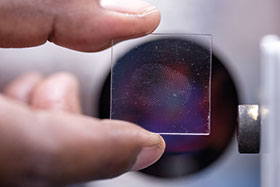

The Council for Scientific and Industrial Research (CSIR), has launched a South African first. A new-generation fingerprinting sensing technology, using high-speed, large-volume optical coherence tomography (OCT).
The CSIR’s OCT device will contribute to law enforcement and forensics in general. Safety and security is a national imperative. Equally important is the industrialisation of South Africa’s research and development into relevant solutions for local challenges.
Funded by the Department of Science and Technology (DST), the OCT project succeeded in taking conventional OCT technology used for fingerprint biometrics, to a much deeper level, literally.
Ann Singh, CSIR laser scientist responsible for OCT, says that OCT uses light to capture, in 3D, the finest of details from biological tissue. It could be likened to ultrasound, but using light.
“It is important to note that the light source of the OCT does not destroy DNA when extracting the latent fingerprints. The differentiating factor of our technology is that the CSIR team has enabled higher-resolution fingerprint acquisition by capturing more substrates of live or latent fingerprints (seen and unseen fingerprints left at crime scenes).
The result is a significantly more accurate and tamper-proof fingerprint representation,” says Singh who also extended her gratitude to the core hardware team – Ameeth Sharma, Rocky Ramokolo, Ted Roberts, Hencharl Strauss and Corrie van der Westhuizen – for their participation and perseverance in seeing this project through.
CSIR senior biometrics research engineer, Rethabile Khutlang, says the contactless nature of OCT means that it can acquire latent fingerprints without destroying potential useful DNA material for forensics. It can also detect sweat glands and can also detect if the subject that is being scanned is dead or alive. These important qualities enhance biometric security features for high-end applications such as military, national security points and forensics.
Crime scene personnel will be able to use the OCT device to scan areas and lift fingerprints without the use of dusting and the risk of contamination. The contactless nature of the scan means that multiple acquisitions are possible; and since OCT is non-destructive, secondary analyses can be performed and used to identify criminals.
Another benefit of the technology, according to CSIR biometrics and image processing researcher Luke Darlow, is the ability to scan fingertips without the need for contact between the scanner and the fingertip.
“This solves the problem of elastic distortion in conventional ‘slap’ scan fingerprint acquisition devices, which is caused by the pressure of a finger on a surface. Since it is contactless, it is also hygienic and residual fingerprints are not left on a scanner surface. In addition, unlike current technology, it is not influenced by moisture conditions or skin damage.
“The CSIR OCT system is capable of acquiring both external and internal fingerprints. Combining these allows for a hybrid fingerprint that results in better biometric performance. The acquisition of such detailed fingerprints means that fake prints can be easily detected,” he says.
“The device launched is the first prototype. The next step is to reduce the size of the device to a hand-held system and prepare for commercialisation. For that we intend to use our Photonics Prototyping Facility (PPF) whose function is to enable the development of prototypes – such as the OCT device – that will result in products that satisfy a market need associated with photonics-based technologies and devices,” says Delon Mudaly, head of the CSIR National Laser Centre.
The CSIR’s OCT technology is not limited to biometrics. It can also be used in fields such as dermatology, ophthalmology and polymer characterisation.
The launch also illustrated the CSIR’s multidisciplinary muscle by using Cmore to demonstrate near real-time forensics. Cmore is an advanced, innovative situation awareness and decision-support platform that exploits modern web and mobile technologies to address the need for shared awareness.
More information on OCT is available at http://www.csir.co.za/docs/OCT_fingerprint_FactSheet.pdf, while a YouTube video can be found at https://www.youtube.com/watch?v=PplA1iyX0Zs&feature=youtu.be (Short URL: securitysa.com/*ypn1).
For more information contact Tendani Tsedu, CSIR media relations manager and acting group manager: Strategic Communications, CSIR, +27 (0)12 841 3417, [email protected]
© Technews Publishing (Pty) Ltd. | All Rights Reserved.